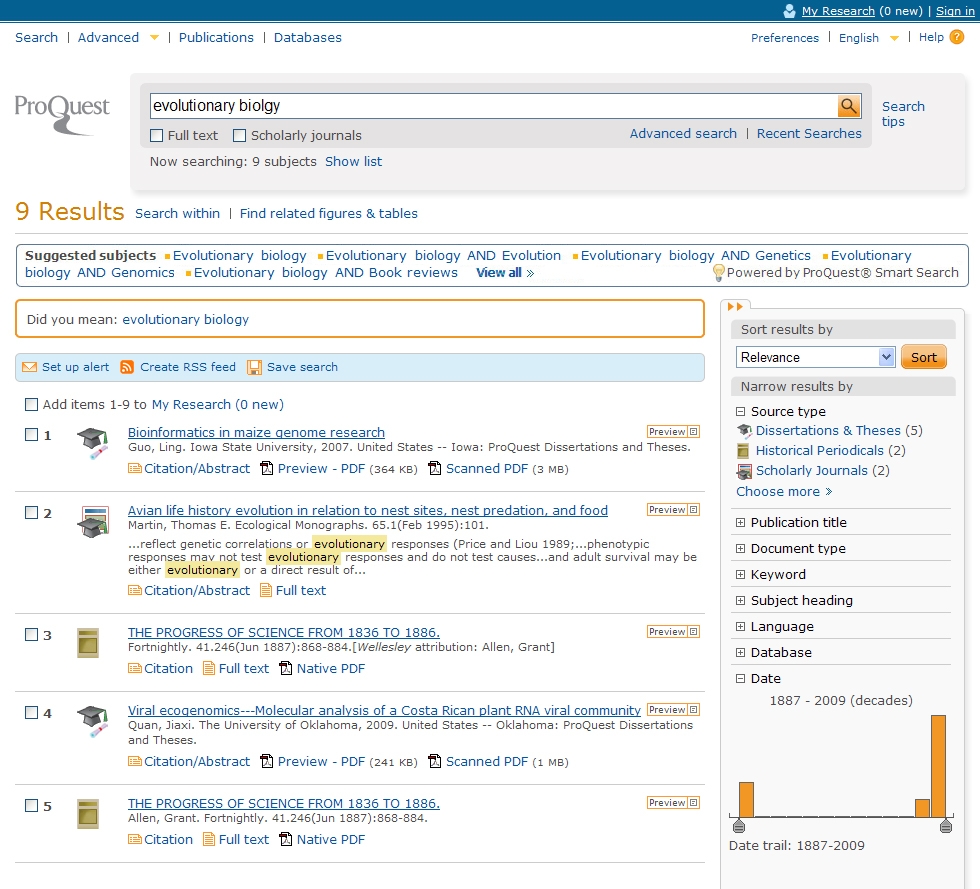
ProQuest unveiled plans at the ALA Annual Conference in Washington, D.C., to roll out a completely redesigned platform this summer. The ground-up redesign promises to unify all ProQuest content into a single framework, while also connecting users to non-ProQuest databases through ProQuest Extended Search, and adding infrastructure to aid users in gathering, sharing, and creating content in ways not possible with its current platform.
“We’ve . . . set an entirely new standard for what users can get from their libraries,” said Marty Kahn, ProQuest CEO, in a June 28 press release. “We’re uncovering needs and new technologies we can use to address them every day.” In a meeting with American Libraries, ProQuest CIO Bipin Patel explained the process behind the redesign as “cracking the code of mass customization.” At one billion documents, ProQuest is the world’s largest Oracle XML database, but by building the interface into those documents “through the eyes of the users,” as Senior Marketing Manager Scott Maynard explained, ProQuest achieves an end-user experience that “delivers the right tools at the right time.”
 ABI/INFORM Global database landing pageIn a information landscape where vendors are often providing the same content over different, competing delivery tools, two factors stand out as providers vie for business: middleware and front-end. By simplifying the middleware, or the software that connects a database to its front end, Patel explained, ProQuest delivers lightning-fast search results because they’ve worked on combining all their datasets into one searchable index.
ABI/INFORM Global database landing pageIn a information landscape where vendors are often providing the same content over different, competing delivery tools, two factors stand out as providers vie for business: middleware and front-end. By simplifying the middleware, or the software that connects a database to its front end, Patel explained, ProQuest delivers lightning-fast search results because they’ve worked on combining all their datasets into one searchable index.
On the front end, the massive, catch-all index means users can search at any of three different levels. First, Maynard demoed a landing page with a single search box to search across multiple databases, so that users are not required to choose a database before beginning a search. Second, users familiar with ProQuest’s databases can search on a specific one, leveraging search techniques unique to each dataset. Third, Proquest offers guided subject searches over multiple databases.
 Search page results pageIn addition to offering better search within its own databases, ProQuest Extended Search enables libraries to build connections between ProQuest databases and content from up to 20 outside providers, using SerialsSolutions linking technology. The company has also taken steps to integrate content from other sites all over the open web. Through Open Web Article Linking, users have access to current popular content within ProQuest search results. The platform already integrates content from Time, and acess into Business Week, Sports Illustrated, and Entertainment Weekly content is forthcoming. Seemless integration is acheived by storing abstracts from outside content in ProQuest’s database and linking out to original articles, Patel explained.
Search page results pageIn addition to offering better search within its own databases, ProQuest Extended Search enables libraries to build connections between ProQuest databases and content from up to 20 outside providers, using SerialsSolutions linking technology. The company has also taken steps to integrate content from other sites all over the open web. Through Open Web Article Linking, users have access to current popular content within ProQuest search results. The platform already integrates content from Time, and acess into Business Week, Sports Illustrated, and Entertainment Weekly content is forthcoming. Seemless integration is acheived by storing abstracts from outside content in ProQuest’s database and linking out to original articles, Patel explained.
The search results page utilizes some features common to search and discovery elsewhere on the web, such as buttons to share articles on social media sites, the ability to narrow results according to publication time period, and article preview pop-ups to reduce click-throughs to unwanted articles.
Because content from multiple databases is unified into one search, ProQuest boasts faster search results and simpler administration of e-resources. In a world where consumers of information are more and more becoming producers of information, Patel noted, adding user-generated content aims to keep the products relevant in a time where user roles are constantly expanding and changing.
Nonetheless, Patel stressed that the new technology architecture is designed “for purpose,” each feature addressing a specific need, so as to avoid extraneous features that don’t add value to the research process. The agile development process is informed by personas, regular testing with live subjects from every user group, and over 6,000 surveys worldwide.
ProQuest will begin migrating its customers to the new platform in late summer.
–Sean Fitzpatrick is associate editor and website manager for American Libraries


